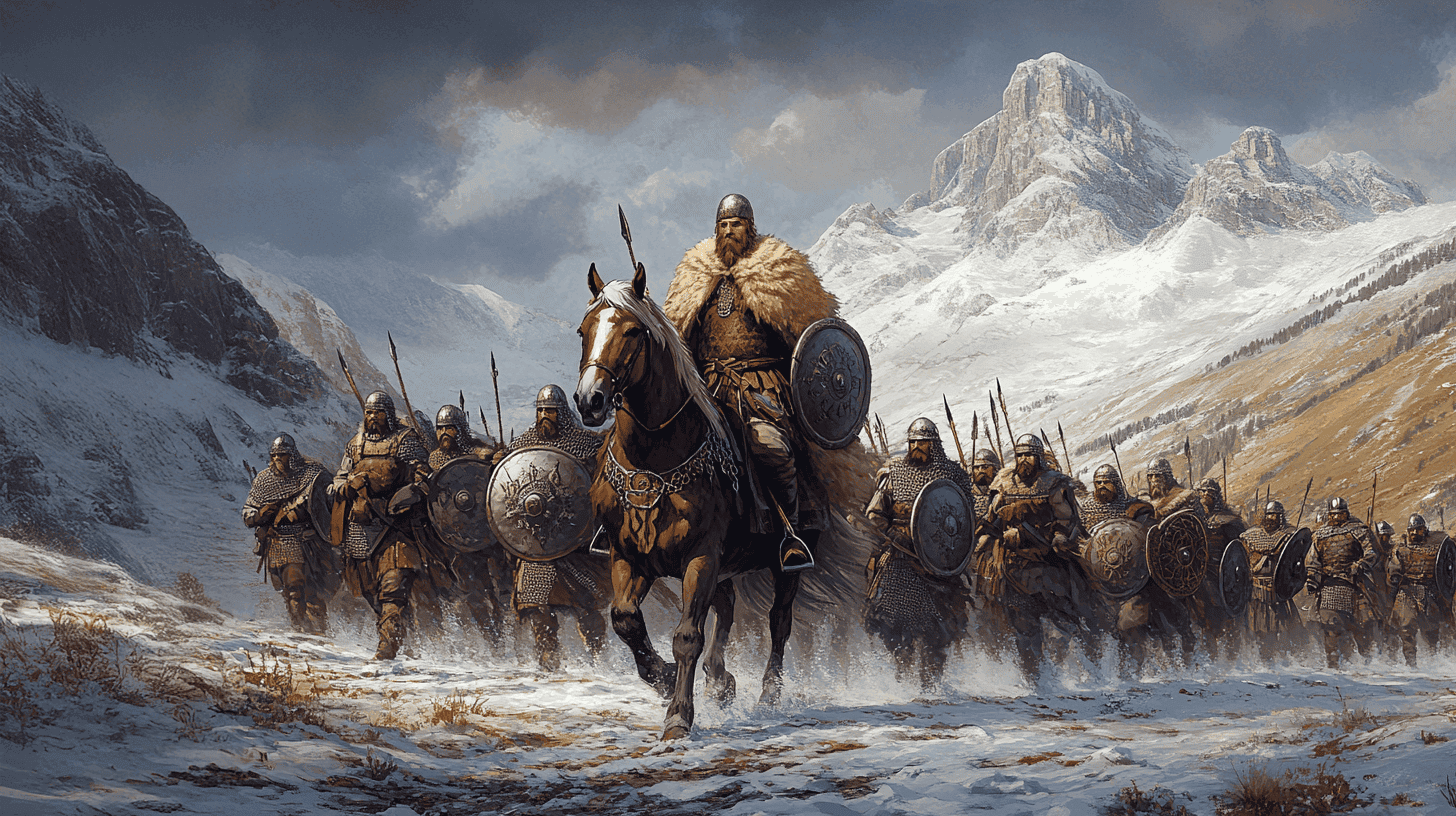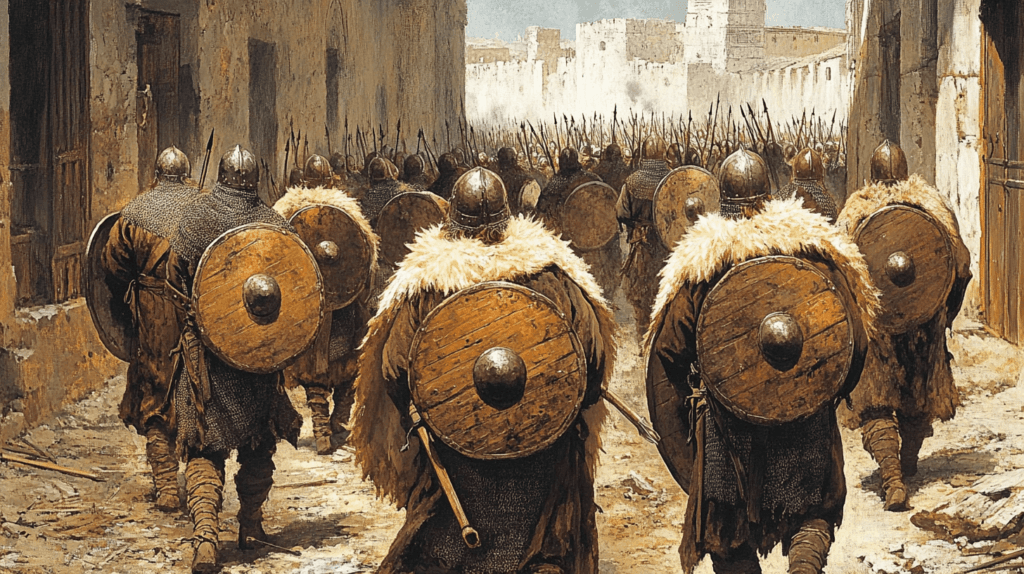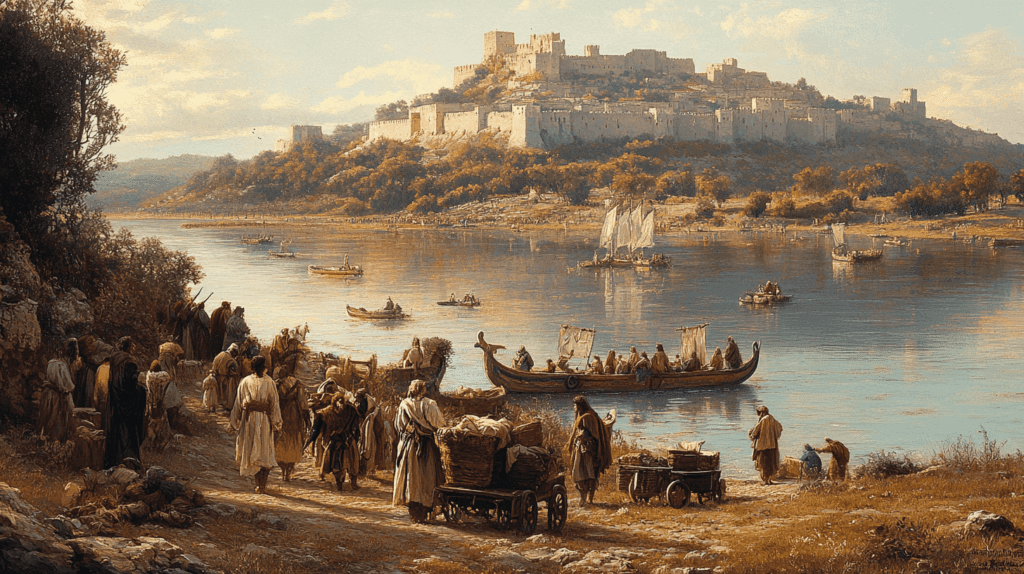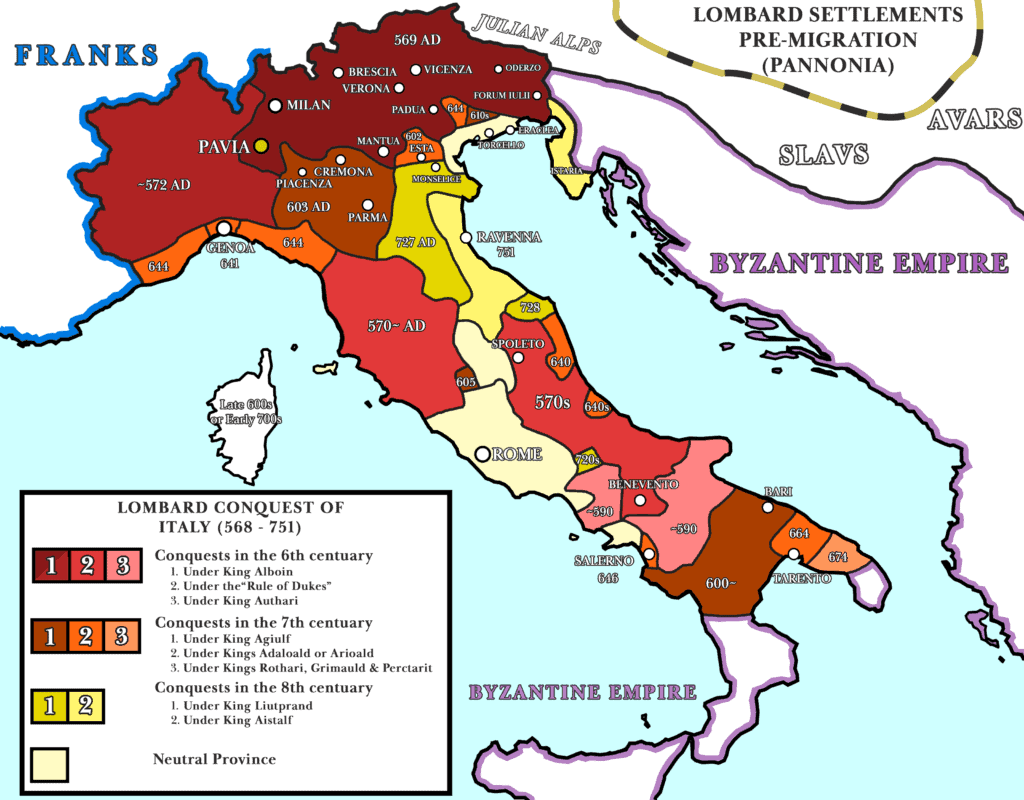
In 568 CE, a pivotal moment in European history unfolded as the Lombards, a Germanic people, crossed the Julian Alps and began their invasion of the Italian Peninsula. This event would reshape the political, social, and cultural landscape of Italy for centuries to come, marking the end of unified Roman rule and ushering in a new era of fragmented governance.
The Lombards: From Pannonia to Italy
The Lombards, also known as Longobards due to their distinctive long beards, originated from Scandinavia and had settled in Pannonia (modern-day western Hungary) by the 6th century. Under the leadership of their ambitious king, Alboin, who had ruled since 560 CE, the Lombards had already proven themselves as a formidable force.
Alboin’s ascension to the Lombard throne in 560 CE marked the beginning of a new chapter for his people. A young and energetic leader, he quickly set about expanding Lombard influence and power. In 566 CE, Alboin achieved a significant victory by defeating the neighboring Gepidae, incorporating them into his realm. To solidify this conquest, he married Rosamund, the daughter of the Gepid king Cunimund.

The Decision to Invade
Several factors contributed to Alboin’s decision to lead his people into Italy:
- Byzantine Weakness: The Italian Peninsula had been left vulnerable following the devastating Gothic War (535-554 CE) between the Byzantine Empire and the Ostrogothic Kingdom.
- Avar Threat: The growing power of the Avars in Pannonia posed a potential threat to Lombard security.
- Opportunity for Conquest: Italy, with its fertile lands and weakened defenses, presented an attractive target for expansion.
The Invasion Begins
In the spring of 568 CE, Alboin led the Lombards across the Julian Alps and into northeastern Italy. This massive migration included not only the Lombards but also a diverse coalition of peoples: Saxons, Heruls, Gepids, Bulgars, Thuringians and Ostrogoths. This multi-ethnic force gave the Lombards additional strength and numbers as they began their conquest.
The Lombard invasion met with surprisingly little resistance. The Byzantine forces left to defend Italy after the Gothic Wars were small and ill-prepared to face such a determined invader. As a result, the Lombards made rapid progress:
- By late 569 CE, they had conquered most of northern Italy, including all major cities north of the Po River, except for Pavia. Pavia, which would later become the capital of the Lombard kingdom, fell after a three-year siege in 572 CE. Simultaneously, Lombard forces pushed into central and southern Italy, establishing a presence throughout the peninsula.

The Establishment of Lombard Rule
As the Lombards advanced, they began to establish a new political and social order in the territories they conquered. One of the most significant aspects of Lombard rule was the establishment of a system of duchies. This decentralized form of governance would have lasting implications for Italian political structure:
The first Lombard duchy was created in Forum Iulii (modern-day Cividale del Friuli) in 569 CE, entrusted to Alboin’s nephew Gisulf. Other important cities such as Vicenza, Verona, and Brescia quickly fell under Lombard control. Milan, the main Roman center of northern Italy, was conquered in the summer of 569.
Byzantine Resistance and Adaptation
The Byzantine Empire, which had controlled the Italian Peninsula prior to the Lombard invasion, did not simply concede their territories without a fight.
The Byzantines established the Exarchate of Ravenna as their primary stronghold in northeastern Italy. This fortified city served as the center of Byzantine resistance and administration in the region.
Unable to match the Lombards in land-based military power, the Byzantines relied on their naval superiority to maintain control of coastal cities. This strategy allowed them to preserve a presence in Italy and continue to challenge Lombard expansion.
The Byzantines also employed diplomatic tactics to weaken Lombard unity: in 572 they were been involved in the assassination of King Alboin, who met a violent end at the hands of his wife Rosamund and conspirators. Rosamund, seeking revenge for her father’s death, orchestrated Alboin’s assassination with the help of his foster brother Helmechis and a bodyguard named Peredeo.

Alboin’s successor, Cleph, ascended to the throne but ruled for a mere 18 months before also falling victim to assassination. Cleph’s death was reportedly carried out by a slave he had mistreated. These back-to-back regicides plunged the Lombard kingdom into a decade-long period of instability known as the “Rule of the Dukes”. During the period of 574-584, when the Lombards had no central king, the Byzantines worked to divide Lombard leadership and buy some duchies into their camp.
The Impact on Italian Society and Culture
The Lombard invasion and settlement had profound effects on the social, cultural, and demographic landscape of Italy.
The arrival of the Lombards triggered significant population shifts as many Italian landowners fled their estates, seeking refuge in Byzantine-controlled territories or fortified cities. Some populations moved to more defensible locations, such as the lagoons that would later become Venice. The city of Oderzo, for example, saw its population flee to Eraclea in the protected lagoon area under Byzantine control.

The Lombard invasion also had religious implications. The bishop of Altino fled the Lombards and settled in Torcello, which became a new bishopric in 639 CE. Over time, the initially Arian Lombards would convert to Catholicism, a process that would have significant political and cultural ramifications.
Linguistic and Cultural Fusion
As the Lombards settled in Italy, a gradual process of cultural and linguistic fusion began:
- The Lombard language influenced the development of Italian dialects, particularly in the north.
- Lombard legal traditions were integrated with Roman law, creating a unique legal system.
- Artistic and architectural styles blended Germanic and Roman influences, giving rise to distinctive Lombard art forms.
Challenges to Lombard Rule
Despite their initial successes, the Lombards faced numerous challenges in consolidating their rule over Italy. The Lombards had to contend with ongoing threats from external powers:
- The Byzantine Empire continued to challenge Lombard control, particularly in coastal regions.
- The Franks, who had previously allied with the Ostrogoths, posed a potential threat from the north.
The Consolidation of the Lombard Kingdom
Despite these challenges, the Lombards gradually consolidated their rule over much of Italy. The accession of King Agilulf (r. 590-616) and his wife Theodelinda marked a turning point in Lombard history, as they strengthened Lombard control over Italian territory while securing borders through peace treaties with France and the Avars. Under their rule, the Lombards systematically violated truces with the Byzantines, leading to further territorial gains between 594 and 603 CE.
During this period, the Lombards significantly expanded their territories:
- In northern Italy, they captured important cities such as Parma, Piacenza, Padua, Monselice, Este, Cremona, and Mantua.
- The southern duchies of Spoleto and Benevento also extended their domains.
- Istria was repeatedly attacked and invaded, although the extent of Lombard control in this region remains unclear.

The Legacy of the Lombard Invasion
The Lombard invasion of 568 CE had far-reaching consequences that shaped the future of Italy and Europe. The arrival of the Lombards broke the political unity of the Italian Peninsula for the first time since the Roman conquest. This fragmentation would characterize Italian politics for centuries to come, influencing the development of city-states and regional identities.
Initially Arian Christians, the Lombards gradually converted to Catholicism. This conversion, completed under King Agilulf and Queen Theodelinda, helped integrate the Lombards with the local population. It also improved relations with the papacy, setting the stage for future alliances.

The Lombard Kingdom in Italy would endure for over two centuries, reaching its zenith under King Liutprand in the 8th century. However, in 774 CE, the kingdom fell to the Frankish king Charlemagne, marking the end of independent Lombard rule in northern Italy.
The Lombard invasion of Italy in 568 CE stands as a watershed moment in European history. It marked the definitive end of unified Roman rule in the Italian Peninsula and ushered in a new era characterized by political fragmentation, cultural synthesis, and dynamic change. The Lombards, who entered Italy as conquerors, gradually became an integral part of Italian society, leaving an indelible mark on the country’s language, law, art, and political structure.




